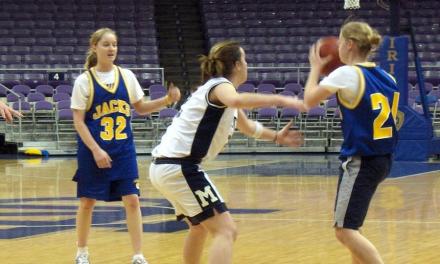Teaching and learning in rounders should be exciting for everyone involved, with rapid progress through innovative practices.
I’m lucky as I work with EYFS right through to top level performers representing their country, both in schools and satellite centres. This has really helped me to develop a long-term plan for teaching rounders, which aims to support all pupils to be ‘the best they can be’ by challenging them through inclusive and innovative lessons. Pupils are stretched physically and mentally in each lesson at a pace suitable for them as an individual.
When differentiated, for example, I try and break this into 2 categories: physical strengths and mental capacity. You may have a player who is below average on their skills but needs to be challenged mentally, while another player may be very gifted with their physical skills, but lack understanding of complex scenarios so need to have the activities simplified while still being challenged physically.
Each lesson contributes to a long term plan and follows a standardised format which encourages children to take ownership of their own learning. This is achieved through a process of self discovery, pupil-led activities, self and peer assessment and video analysis.
Simple analogies are applied to each skill, used by pupils as a quick and easy check on their own, and others performances. For example, ‘9 o’clock, 6 o’clock, 3 o’clock’ for an underarm throw, ‘straight, corner, superman’ for an over arm throw. As early as KS1, pupils are able to break down the technique for each skill using the process I refer to as ‘SAF’. The following would be applied to the advanced bowling technique:
Stance: sideways to the batter, feet together
Action: step, together, slam. Arm at 6 o’clock
Finish: face batter, hips low, release at 3 o’clock
It’s great to hear children referencing these teaching points during lessons, and seeing them support and coach each other voluntarily is so much more rewarding than using prescribed, unrealistic activities. The key is establishing these habits in KS1, then by the time they hit KS3, pupils already have a level of performance that simply needs enhancing rather than having to start from scratch!
Every activity is implemented with the end goal of children being ‘the best they can be’ in mind, and is always directly relevant to the sport. Starting with a sport specific warm up is so beneficial, and always applicable, even in KS1.
If the focus of the session is batting in KS3, the warm up would focus on activities that incorporate lots of hand-eye coordination such as keep-ups with an air flow/sponge ball. This can progress from working individually to perform dynamic movements such as keep-ups, to working in pairs, moving around a given area, avoiding others whilst tapping the ball to each other with their batting hand.
Just by adding the keep-ups, it completely transforms the dynamics of a standard and predictable warm up to something that is multi-dimensional; encouraging awareness of space, team work, communication, hand-eye coordination and movement skills. It’s easily progressed to challenge and focus pupils without losing the objective of warming up, and is contributing to the main focus of the lesson, allowing more time for greater progress.
Drills and adapted games are implemented in a way that is always relevant to the sport. For example, when teaching the long barrier, I stay away from retrieving a rolling ball and then rolling back to a partner ‘ it’s dull, predictable and players will never do this in a game so why practise in a lesson?
Instead, adapt the formation so you have a ‘batter’, a fielder and a post fielder, who all rotate between the positions. When they are the fielder, they travel to a moving ball from the batter, perform the long barrier then send the ball to the post to prevent the batter from scoring. This simple drill can be adapted and progressed in so many ways to develop different aspects of the game.
Example
The post fielder starts as the bowler, delivers to the batter who throws/hits it into a space, runs as normal applying the rules of running around the track.
The fielder moves to attack the ball, performs the long barrier, then sends the ball (selecting and applying a throw suitable for the distance) to the bowler, who is now on a post in front of the batter to try and stop them running any more posts.
Not only does this practise a variety of skills, it brings in decision making and new tactics where the bowler covers the posts after he/she has delivered the ball to the batter, which frees up ‘post fielders’ to go and field.
As you progress this activity, it provides several opportunities to introduce different rules such as stumping the post in front of the live batter stops them gaining any further score and stumping the post the batter is running to gets them out.
This is a rule that causes a lot of confusion in schools but just remember, there are no other variations on these 2 points, i.e. there is no such term as a ‘mis-field’ in relation to the rules: once a post is stumped, it never becomes ‘unstumped’ regardless of what happens to the ball. A batter may run to a post that has been stumped but will not score from it. They are only out if the fielders ‘stump’ the post the batter is running to.
I challenge my groups to create quirky phrases, raps, songs or dances which help them to remember the rules. This example shows a group from Wright Robinson College, Manchester performing a song which refers to the rules about the main no balls.
Baseline tests are implemented for assessment, replacing the old system of levels. These are performed in week 1, with the same tests repeated again in week 10. Pupils record their top score of 3 performances on each test. Start and end results are then compared to show progress. Statistics can then be used to form the base for ICT and numeracy lessons, often engaging pupils who are not usually turned on by these subjects.
I run a 10 week unit of work which provides additional opportunities for teaching and learning, resulting in greater progress and confidence in the sport. I am currently working with a number of primary schools to establish ‘setting’ in PE. Whole year groups will be split based on ability in PE rather than just teaching whole classes.
This has many advantages but the biggest for me is the improvements seen in the competition element as children are competing in realistic scenarios against those at a similar level. Less able performers, therefore, are not persistently ‘losing’ and getting turned off the sport, while higher end performers are stretched and engaged at a level right for them and have a more realistic view of where they sit across their age group.










